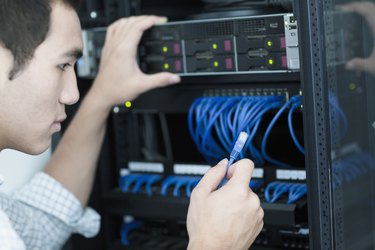
A Network Interface Card -- or NIC -- is an add-on device that enables a computer to communicate with other computers. When multiple computers are linked together using NICs or other devices, the resulting group is called a "network." In fact, when you connect your computer to the Internet, you are connecting it to the world's largest network. Today, most computers have built-in functionality equivalent to that of a NIC and only require add-on cards under special circumstances.
About Network Interface Cards
Video of the Day
A wired computer network uses cables called "Ethernet" or "RJ45" to move data between client computers, switches, routers and servers. A NIC provides a computer with the required interface for an Ethernet cable and also provides the translation necessary to convert data into a form that can be transmitted over the cable. Most desktop and notebook computers have motherboards with built-in Ethernet ports and don't require add-on cards to connect to Ethernet-based networks. However, some thin notebook computers lack Ethernet ports. Instead, these notebooks have built-in adapters for connecting to wireless networks.
Video of the Day
Uses of Network Interface Cards
If have an older desktop computer or thin notebook without a built-in Ethernet port, you'll need to install a NIC to connect the computer to a wired network. In addition, it is occasionally advantageous to install a NIC in a computer that already has an Ethernet port. For example, network-attached storage devices typically connect to a network via Ethernet. Adding a NIC to your desktop computer would allow you to connect your computer to both a router and a network-attached storage device using separate Ethernet cables and share the storage device with other computers on the network. In addition, adding a NIC to a computer may allow it to transmit data on a network more quickly; modern NICs transmit data at up to one gigabit per second, while older NICs transmit at 10 or 100 megabits per second.
Installing a Network Interface Card (Desktop Computer)
If you have a desktop computer, you'll need to open its chassis to install a NIC. Before doing this, confirm that opening your computer won't void the warranty and check the instruction manual for information relevant to your computer's model. In most cases, a computer's chassis has a release lever or screw that must be removed for entry. Upon opening the chassis, locate an open expansion port and push the NIC into it. After you have installed the NIC and closed the computer's chassis, start the computer and wait for the message "Installing device driver software" to appear in the corner of the screen. Windows-based and Mac computers include the device drivers for most NICs and can install the device drivers automatically. In this case, you can begin using the NIC as soon as the "Installing" message disappears. If your computer prompts you to install a device driver manually, insert the disc included with the NIC and follow the instructions to install the required support software.
Installing a Network Interface Card (Notebook Computer)
Most NICs for notebook computers are external and connect to a USB port, allowing installation without opening the computer's chassis. However, some older notebook computers have expansion card slots accessible from the outside of the computer. To install this type of NIC, use the release button next to the expansion card slot and remove the plastic spacer. Slide the NIC into the slot and push gently until it is fully seated.